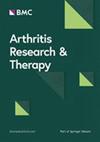JAK-STAT信号和粒细胞-巨噬细胞集落刺激因子在类风湿关节炎骨炎发展和骨微结构改变中的作用
IF 4.6
2区 医学
Q1 Medicine
引用次数: 0
摘要
磁共振成像(MRI)上的骨炎和高分辨率外围定量计算机断层扫描(CT)上的骨微结构改变(BMC)是关节炎的最早征兆,在类风湿关节炎(RA)的x线上表现为骨侵蚀之前。最近,据报道,一种Janus激酶(JAK)抑制剂baricitinib可以抑制这些早期变化。本研究旨在通过RA动物模型和人类样本阐明骨炎和BMC的潜在分子机制。通过MRI和micro-CT分别评估zymoshan处理的SKG小鼠的骨炎和BMCs。流式细胞术检测骨髓(BM)细胞。通过定量PCR检测jak -信号转导和转录激活因子(STAT)的表达。zymosan处理的SKG小鼠接受了baricitinib、抗粒细胞-巨噬细胞集落刺激因子(GM-CSF)抗体或重组GM-CSF (r-GM-CSF)。r-GM-CSF也用于体外破骨细胞分化试验。破骨细胞分化也用人单核细胞进行了研究。骨炎和bmc发生在SKG小鼠关节炎之前。粒细胞-巨噬细胞谱系细胞和破骨细胞前体细胞(ocp)在炎症性脑脊膜炎中扩增。在BMC部位观察到核因子κ b配体阳性破骨细胞的受体激活物。JAK-STAT细胞因子GM-CSF在骨性脑脊髓炎中表达上调。巴西替尼和抗gm - csf抗体均抑制骨炎和骨髓基质细胞,而r-GM-CSF则加重了这些变化。体外在破骨细胞分化实验中添加r-GM-CSF,可显著增加破骨细胞的数量和大小,尤其是在小鼠和人的破骨细胞分化后期添加时。GM-CSF通过增加粒细胞-巨噬细胞谱系细胞和ocp以及促进破骨细胞分化来驱动骨炎和bmc。靶向GM-CSF是预防RA早期影像学改变的潜在治疗策略。本文章由计算机程序翻译,如有差异,请以英文原文为准。
Roles of JAK-STAT signaling and granulocyte–macrophage colony-stimulating factor in the development of osteitis and bone microstructure changes in rheumatoid arthritis
Osteitis on magnetic resonance imaging (MRI) and bone microstructure changes (BMC) on high-resolution peripheral quantitative computed tomography (CT) are the earliest signs of arthritis, preceding the development of bone erosion on X-ray in rheumatoid arthritis (RA). Recently, a Janus kinase (JAK) inhibitor, baricitinib, reportedly suppresses these early changes. This study aimed to elucidate the underlying molecular mechanism of osteitis and BMC using an animal model of RA and human samples. Osteitis and BMCs were assessed via MRI and micro-CT, respectively, in zymosan-treated SKG mice. Bone marrow (BM) cells were analysed via flow cytometry. JAK‒signal transducer and activator of transcription (STAT) cytokine expression was measured via performing quantitative PCR. Zymosan-treated SKG mice received baricitinib, anti-granulocyte‒macrophage colony-stimulating factor (GM-CSF) antibodies, or recombinant GM-CSF (r-GM-CSF). r-GM-CSF was also used in an in vitro osteoclast differentiation assay. Osteoclast differentiation was also investigated with human monocytes. Osteitis and BMCs occurred prior to arthritis in SKG mice. Granulocyte‒macrophage-lineage cells and osteoclast precursor cells (OCPs) expanded in the inflammatory BM. Receptor activator of nuclear factor kappa-B ligand-positive osteoclasts were observed at BMC sites. The expression of GM-CSF, a JAK‒STAT cytokine, was upregulated in osteitic BM. Both baricitinib and anti-GM-CSF antibodies suppressed osteitis and BMCs, whereas r-GM-CSF exacerbated these changes. In vitro addition of r-GM-CSF to osteoclast differentiation assay markedly increased the number and size of osteoclasts, especially when added in the late phase of osteoclast differentiation both in mice and humans. GM-CSF drives osteitis and BMCs by increasing granulocyte‒macrophage-lineage cells and OCPs and promoting osteoclast differentiation. Targeting GM-CSF is a potential therapeutic strategy to prevent early radiographic changes in RA.
求助全文
通过发布文献求助,成功后即可免费获取论文全文。
去求助
来源期刊

Arthritis Research & Therapy
RHEUMATOLOGY-
CiteScore
8.60
自引率
2.00%
发文量
261
审稿时长
14 weeks
期刊介绍:
Established in 1999, Arthritis Research and Therapy is an international, open access, peer-reviewed journal, publishing original articles in the area of musculoskeletal research and therapy as well as, reviews, commentaries and reports. A major focus of the journal is on the immunologic processes leading to inflammation, damage and repair as they relate to autoimmune rheumatic and musculoskeletal conditions, and which inform the translation of this knowledge into advances in clinical care. Original basic, translational and clinical research is considered for publication along with results of early and late phase therapeutic trials, especially as they pertain to the underpinning science that informs clinical observations in interventional studies.
 求助内容:
求助内容: 应助结果提醒方式:
应助结果提醒方式:


